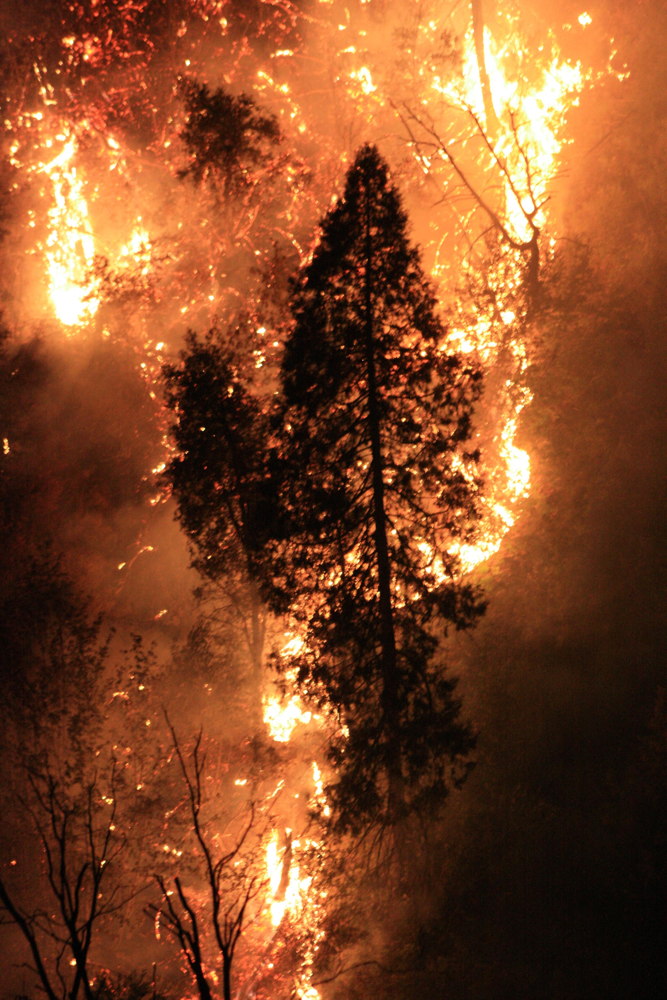
Experimental forests that have been groomed to slow wildfires could reduce the frequency of catastrophic fires in the future, researchers say.
The decade-long project to slow and contain forest fires could become a blueprint for fire management across California. The project, which was developed in an experimental forest at the University of California at Berkeley's Sagehen Creek Field Station near Lake Tahoe in California, creates pockets of thinner trees in areas where the fire risk is high, while still leaving pockets of dense growth for wildlife habitat.
"The idea is that you coordinate treatments to change fire behavior across a landscape — a big landscape," said John J. Battles, a Berkeley forest ecologist who helped develop the method.
The forest in the Sierra has evolved to thrive with frequent, small fires that consume saplings and brush on the forest floor. For instance, giant sequoia cones are sealed by a glue that only melts in fire, releasing their seeds.
But conflagrations like the recent Rim Fire — California's fourth-largest wildfire in recorded history and the largest forest fire in the Sierra — happen, in part, because a century of fire suppression and replanting has left forests overgrown, with thick underbrush and cramped trees providing the perfect fuel for blazing hot fires. Hot fires scorch the earth, burning seeds in the ground and the carbon in the soil, and thus potentially changing the forest permanently. [Yosemite Aflame: Rim Fire in Photos]
Targeted management
The easiest way to contain or slow the spread of wildfire is to thin the forest. But old forests also provide habitat for iconic animals, such as the California spotted owl and the American marten. Many areas are too steep to reach with bulldozers to rip out trees, said Scott Conway, a vegetation management officer with the U.S. Forest Service in the Tahoe National Forest, who is also involved with the project.
Sign up for the Live Science daily newsletter now
Get the world’s most fascinating discoveries delivered straight to your inbox.
Fire researchers are using models of the landscape and tree density, local weather patterns and historical fire data, combined with habitat information, to find the areas that are likeliest to burn catastrophically. The idea is that by treating only a portion of an area — typically about a third — fire managers can slow the spread of fire across the entire landscape, Battles said.
"By treating in certain spots, the fire never really gets rolling hot," Battles told LiveScience.
For instance, northeast-facing slopes are likely to be cooler and wetter — and, therefore, less fire-prone — than southwest-facing slopes or ridgetops exposed to wind. Fire tends to race up steeper slopes more swiftly than flatter areas. Therefore, fire managers often treat southwest-facing slopes and the flatter areas around steeper slopes that can't be reached by bulldozers.
"We would only strategically treat a portion of the landscape but in spots where we knew fire normally comes from," Conway told LiveScience's OurAmazingPlanet. "When fire hits one of these [treated areas], it's forced to slow down and flank around these treatments."
Broad deployment
The strategy has been used in a few experimental forests: at the Sagehen Creek Field Station near Truckee, Calif., as well as the American River Ranger District of the Tahoe National Forest.
The method allows firefighters to actually protect critical areas, Conway said. (If the fire burns too hot, firefighters can do very little to contain it.)
The plan is to expand the method across the entire Sierra Nevada in order to reduce the frequency of catastrophic fires like the Rim Fire.
The researchers may already have a chance to see how their approach has worked: A fire is burning in the treated area of the American River Ranger District.
Once the fire dies out, the team will have a rare chance to see how the new technique worked in action, Conway said.
Follow Tia Ghose on Twitter and Google+. Follow LiveScience @livescience, Facebook & Google+. Original article on LiveScience.

Tia is the managing editor and was previously a senior writer for Live Science. Her work has appeared in Scientific American, Wired.com and other outlets. She holds a master's degree in bioengineering from the University of Washington, a graduate certificate in science writing from UC Santa Cruz and a bachelor's degree in mechanical engineering from the University of Texas at Austin. Tia was part of a team at the Milwaukee Journal Sentinel that published the Empty Cradles series on preterm births, which won multiple awards, including the 2012 Casey Medal for Meritorious Journalism.









